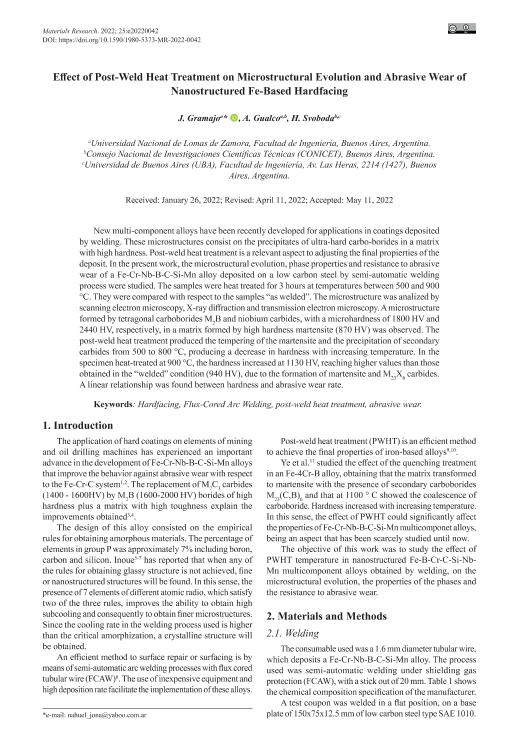Mostrar el registro sencillo del ítem
dc.contributor.author
Gramajo, Jonathan Nahuel

dc.contributor.author
Gualco, Agustín

dc.contributor.author
Svoboda, Hernán Gabriel

dc.date.available
2023-10-05T14:57:14Z
dc.date.issued
2022-05
dc.identifier.citation
Gramajo, Jonathan Nahuel; Gualco, Agustín; Svoboda, Hernán Gabriel; Effect of Post-Weld Heat Treatment on Microstructural Evolution and Abrasive Wear of Nanostructured Fe-Based Hardfacing; Universidade Federal de São Carlos; Materials Research; 25; 5-2022; 1-9
dc.identifier.issn
1516-1439
dc.identifier.uri
http://hdl.handle.net/11336/214251
dc.description.abstract
New multi-component alloys have been recently developed for applications in coatings deposited by welding. These microstructures consist on the precipitates of ultra-hard carbo-borides in a matrix with high hardness. Post-weld heat treatment is a relevant aspect to adjusting the final propierties of the deposit. In the present work, the microstructural evolution, phase properties and resistance to abrasive wear of a Fe-Cr-Nb-B-C-Si-Mn alloy deposited on a low carbon steel by semi-automatic welding process were studied. The samples were heat treated for 3 hours at temperatures between 500 and 900°C. They were compared with respect to the samples "as welded". The microstructure was analized by scanning electron microscopy, X-ray diffraction and transmission electron microscopy. A microstructure formed by tetragonal carboborides M2B and niobium carbides, with a microhardness of 1800 HV and 2440 HV, respectively, in a matrix formed by high hardness martensite (870 HV) was observed. The post-weld heat treatment produced the tempering of the martensite and the precipitation of secondary carbides from 500 to 800°C, producing a decrease in hardness with increasing temperature. In the specimen heat-treated at 900°C, the hardness increased at 1130 HV, reaching higher values than those obtained in the "welded" condition (940 HV), due to the formation of martensite and M23X6 carbides. A linear relationship was found between hardness and abrasive wear rate.
dc.format
application/pdf
dc.language.iso
eng
dc.publisher
Universidade Federal de São Carlos

dc.rights
info:eu-repo/semantics/openAccess
dc.rights.uri
https://creativecommons.org/licenses/by/2.5/ar/
dc.subject
ABRASIVE WEAR
dc.subject
FLUX-CORED ARC WELDING
dc.subject
HARDFACING
dc.subject
POST-WELD HEAT TREATMENT
dc.subject.classification
Ingeniería de los Materiales

dc.subject.classification
Ingeniería de los Materiales

dc.subject.classification
INGENIERÍAS Y TECNOLOGÍAS

dc.title
Effect of Post-Weld Heat Treatment on Microstructural Evolution and Abrasive Wear of Nanostructured Fe-Based Hardfacing
dc.type
info:eu-repo/semantics/article
dc.type
info:ar-repo/semantics/artículo
dc.type
info:eu-repo/semantics/publishedVersion
dc.date.updated
2023-07-07T22:57:59Z
dc.journal.volume
25
dc.journal.pagination
1-9
dc.journal.pais
Brasil

dc.description.fil
Fil: Gramajo, Jonathan Nahuel. Universidad Nacional de Lomas de Zamora; Argentina
dc.description.fil
Fil: Gualco, Agustín. Consejo Nacional de Investigaciones Científicas y Técnicas; Argentina. Universidad Nacional de Lomas de Zamora; Argentina
dc.description.fil
Fil: Svoboda, Hernán Gabriel. Consejo Nacional de Investigaciones Científicas y Técnicas. Oficina de Coordinación Administrativa Houssay. Instituto de Tecnologías y Ciencias de la Ingeniería "Hilario Fernández Long". Universidad de Buenos Aires. Facultad de Ingeniería. Instituto de Tecnologías y Ciencias de la Ingeniería "Hilario Fernández Long"; Argentina
dc.journal.title
Materials Research

dc.relation.alternativeid
info:eu-repo/semantics/altIdentifier/url/https://www.scielo.br/j/mr/a/VkXTnxNv6cGYnKrV4nkZd5r/?lang=en
dc.relation.alternativeid
info:eu-repo/semantics/altIdentifier/doi/https://doi.org/10.1590/1980-5373-MR-2022-0042
Archivos asociados
